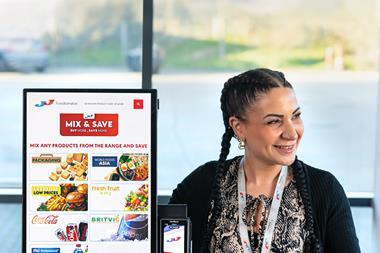The category enjoyed buoyant sales at the height of the recession, but over the past year its fortunes have deteriorated – just as the economy’s have picked up. Why, asks Beth Phillips
For a salutary lesson in how damaging heavy promotional activity can be to a category, look no further than the pasta category.
Last year, it was riding high. Despite commodity price rises pushing value sales up an eyewatering 16.1%, it pulled off solid volume growth of 5% in 2009 and was hailed as one of the big recession success stories.
You might have expected this year to be better still given the improvement in the economy and the fact prices have not risen sharply yet. But paradoxically, just as the economy's fortunes have improved, pasta's have deteriorated. Volume and value growth have dwindled to just 3.1% and 0.3% respectively, while pasta sauce sales have grown just 1.1% and 3.5% [Kantar 52w/e 8 August 2010].
Some of the big players are already questioning the merit of sacrificing value at the altar of volume. Others are questioning more than that. Last month, below-target sales prompted Birds Eye to scrap its range of frozen Italian pasta meals after just a year. The move followed Unilever's decision in September to put pasta sauce brand Ragu up for sale.
But although three of the top five pasta brands and pasta sauce brands alike have seen value sales fall (see right), could the category's fortunes now be looking up?
Premier Foods, for one, believes they are and attributes this in part to the high level of promotions. "Loyd Grossman has experienced a slower start to 2010 following the heavy promotional activity last year," it admits in its first-half report. "But, importantly, household penetration of Loyd Grossman products continues to show the benefit of this push."
Promotions are a necessary evil, argues Carine San Juan, head of category at Premier Foods. "On average, branded products in the category are promoted 60% of the year, and own label about 20% of the year," she says. "It's like a chicken and egg scenario. Manufacturers are willing to promote, and, for retailers, products in the category are mainstream family products, so it's a great way for retailers to demonstrate their value credentials."
Interestingly, there is little correlation between the level of savings offered and the impact on value sales. Among those that offered the biggest discounts, some such as De Cecco saw an uplift in value sales, while others such as Buitoni posted a significant fall.
However, says San Juan, the depth if not the number of promotions has started to shrink. "There was an increase in the number of promotions in the sector, but the deals have got slightly less deep and we envisage this trend carrying on."
The discounts are certainly not as steep as they were on the Giovanni Rana brand, says Stephen Hull, brand development director for Giovanni Rana. "Promotional intensity has reduced in the past year, partly due to less heavy discounting by the brand," he says.
According to Assosia, the percentage of space allocated to pasta and pasta sauces compared with overall space dipped 0.17 percentage points last year, from 0.9% between October 2008 and September 2009, to 0.73% between October 2009 and September 2010. Only Tesco and Waitrose increased their space and they were also the only retailers among the big five to increase the number of promotions in the category.
Promotions are likely to be further tempered by the cost of wheat. It hit a two-year high in September, putting renewed upward pressure on prices.
General wheat prices are up 60% on last year, says Alex Waugh, director general of the National Association of British and Irish Millers. "Durum follows wheat, so it is also up a lot year-on-year," he adds. "This will undoubtedly feed through because businesses aren't going to be able to absorb these prices."
To compound the problem, bad planting conditions in the US and Canada, the UK's main sources of durum wheat, mean stocks are down. "Prices have gone up," says Nigel Singh, UK commercial manager of Pasta Lensi. "Since July, when the harvest was in full swing, list prices in the key Bologna market have gone up about 20% to 25%."
This increase hasn't been passed on to the consumer yet, he adds, because companies buy their stock in three-month batches. "Companies will be covered through to November, when they start buying for January to March," he explains. "That's when prices could start moving, but even then, it's more likely to be through a reduced number of promotions, or fewer deep ones."
The vulnerability of the sector underlines how important investment is and explains why the biggest brands haven't scrimped on the advertising. Last month Giovanni Rana launched a £2.5m campaign to educate consumers about the key benefits of its brand and the category. Central to this is a 30-second TV ad featuring new brand ambassador Tim Lovejoy presenter of BBC2's Something for the Weekend demonstrating the ease of cooking fresh pasta. The ad is backed by an 11-week hot food sampling campaign in 60 Sainsbury's and Asda stores.
Dolmio, too, has been working to educate its customers, with a PR campaign earlier this year involving TV property show presenter Kirstie Allsopp showing shoppers how easy it is to cook Dolmio lasagne. And the brand is turning to the British public in its latest ad campaign, Do it like Dolmio, launched last month. The £2.7m campaign encourages shoppers to submit videos of themselves impersonating the puppets. "This is the first time Dolmio has involved members of the public in their ads," says Wendy Wing, customer marketing manager for Mars Food UK. "But the ads also promote a series of recipes, highlighting the taste and versatility of the Dolmio Bolognese range of cooking sauces."
Suppliers aren't taking their foot off the NPD gas either (see Innovations p56) and don't seem put off by the slowing down of the market. Restaurant chain PizzaExpress, for example, extended its growing retail range into pasta sauces last month. Charlotte Dewhurst, marketing manager for supplier All About Food, said: "We see so many pasta sauces professing Italian heritage but made in the UK. We wanted to create a range with a true Italian heritage." Similarly optimistic about the market, Garofalo launched its Signature Pasta in December last year, while Giovanni Rana established its first full UK subsidiary.
One sub-category that does not appear to need heavy advertising, promotions or NPD to thrive, however, is the pasta bake sub-category. Kantar doesn't measure sales of these special, thicker sauces, but according to Symphony IRI sales leapt 10.1% by value last year and 5.6% by volume [SymphonyIRI], with Homepride, Dolmio and own label leading the way.
"No-frills affluents," are tapping into pasta bake territory, believes Wing. "The turbulent economic climate has forced many consumers, including above-average earners, to tighten their belts and budget their expenditure closely," she says. "Household budgets, shopping plans and online price comparing have become the new focus as consumers look to save money on their everyday grocery spend."
Another success story, claims Singh, is dried pasta shapes aimed at children. The market for canned children's pasta may have slumped from £13m five years ago to £7m now, with shoppers able to pick up three cans for £1 in Poundland, but dried pasta is up 35% year-on-year, he says.
Last month Thomas the Tank Engine dried pasta launched in Tesco, and a whole host of cartoon favourites are also now in pasta format, including The Simpsons, Scooby-Doo and Bob the Builder.
Recent changes in school dinners have boosted sales, he claims. "Schools have clamped down on burgers and chips and have introduced pasta as a replacement," says Singh. "Children tell their parents what they had for lunch at school and then ask for it at home."
There are other encouraging signs across the category as a whole. Sales have picked up in the past few months. According to San Juan, in the past 12 weeks Loyd Grossman sales have risen 7.8% by value and Homepride's by almost 26%. "It's a category where the penetration is in growth so more people are buying into it, and the average rate of purchase is in growth as well, which is the holy grail," she says.
Napolina acting marketing director Dean Towey thinks the continued economic downturn will continue to boost pasta sales as long as promotions aren't used too heavily. He may be right, but whether the British shopper or the economy, for that matter does what the pasta industry wants them to do, remains to be seen.
Focus On Pasta & Pasta Sauces
For a salutary lesson in how damaging heavy promotional activity can be to a category, look no further than the pasta category.
Last year, it was riding high. Despite commodity price rises pushing value sales up an eyewatering 16.1%, it pulled off solid volume growth of 5% in 2009 and was hailed as one of the big recession success stories.
You might have expected this year to be better still given the improvement in the economy and the fact prices have not risen sharply yet. But paradoxically, just as the economy's fortunes have improved, pasta's have deteriorated. Volume and value growth have dwindled to just 3.1% and 0.3% respectively, while pasta sauce sales have grown just 1.1% and 3.5% [Kantar 52w/e 8 August 2010].
Some of the big players are already questioning the merit of sacrificing value at the altar of volume. Others are questioning more than that. Last month, below-target sales prompted Birds Eye to scrap its range of frozen Italian pasta meals after just a year. The move followed Unilever's decision in September to put pasta sauce brand Ragu up for sale.
But although three of the top five pasta brands and pasta sauce brands alike have seen value sales fall (see right), could the category's fortunes now be looking up?
Premier Foods, for one, believes they are and attributes this in part to the high level of promotions. "Loyd Grossman has experienced a slower start to 2010 following the heavy promotional activity last year," it admits in its first-half report. "But, importantly, household penetration of Loyd Grossman products continues to show the benefit of this push."
Promotions are a necessary evil, argues Carine San Juan, head of category at Premier Foods. "On average, branded products in the category are promoted 60% of the year, and own label about 20% of the year," she says. "It's like a chicken and egg scenario. Manufacturers are willing to promote, and, for retailers, products in the category are mainstream family products, so it's a great way for retailers to demonstrate their value credentials."
Interestingly, there is little correlation between the level of savings offered and the impact on value sales. Among those that offered the biggest discounts, some such as De Cecco saw an uplift in value sales, while others such as Buitoni posted a significant fall.
However, says San Juan, the depth if not the number of promotions has started to shrink. "There was an increase in the number of promotions in the sector, but the deals have got slightly less deep and we envisage this trend carrying on."
The discounts are certainly not as steep as they were on the Giovanni Rana brand, says Stephen Hull, brand development director for Giovanni Rana. "Promotional intensity has reduced in the past year, partly due to less heavy discounting by the brand," he says.
According to Assosia, the percentage of space allocated to pasta and pasta sauces compared with overall space dipped 0.17 percentage points last year, from 0.9% between October 2008 and September 2009, to 0.73% between October 2009 and September 2010. Only Tesco and Waitrose increased their space and they were also the only retailers among the big five to increase the number of promotions in the category.
Promotions are likely to be further tempered by the cost of wheat. It hit a two-year high in September, putting renewed upward pressure on prices.
General wheat prices are up 60% on last year, says Alex Waugh, director general of the National Association of British and Irish Millers. "Durum follows wheat, so it is also up a lot year-on-year," he adds. "This will undoubtedly feed through because businesses aren't going to be able to absorb these prices."
To compound the problem, bad planting conditions in the US and Canada, the UK's main sources of durum wheat, mean stocks are down. "Prices have gone up," says Nigel Singh, UK commercial manager of Pasta Lensi. "Since July, when the harvest was in full swing, list prices in the key Bologna market have gone up about 20% to 25%."
This increase hasn't been passed on to the consumer yet, he adds, because companies buy their stock in three-month batches. "Companies will be covered through to November, when they start buying for January to March," he explains. "That's when prices could start moving, but even then, it's more likely to be through a reduced number of promotions, or fewer deep ones."
The vulnerability of the sector underlines how important investment is and explains why the biggest brands haven't scrimped on the advertising. Last month Giovanni Rana launched a £2.5m campaign to educate consumers about the key benefits of its brand and the category. Central to this is a 30-second TV ad featuring new brand ambassador Tim Lovejoy presenter of BBC2's Something for the Weekend demonstrating the ease of cooking fresh pasta. The ad is backed by an 11-week hot food sampling campaign in 60 Sainsbury's and Asda stores.
Dolmio, too, has been working to educate its customers, with a PR campaign earlier this year involving TV property show presenter Kirstie Allsopp showing shoppers how easy it is to cook Dolmio lasagne. And the brand is turning to the British public in its latest ad campaign, Do it like Dolmio, launched last month. The £2.7m campaign encourages shoppers to submit videos of themselves impersonating the puppets. "This is the first time Dolmio has involved members of the public in their ads," says Wendy Wing, customer marketing manager for Mars Food UK. "But the ads also promote a series of recipes, highlighting the taste and versatility of the Dolmio Bolognese range of cooking sauces."
Suppliers aren't taking their foot off the NPD gas either (see Innovations p56) and don't seem put off by the slowing down of the market. Restaurant chain PizzaExpress, for example, extended its growing retail range into pasta sauces last month. Charlotte Dewhurst, marketing manager for supplier All About Food, said: "We see so many pasta sauces professing Italian heritage but made in the UK. We wanted to create a range with a true Italian heritage." Similarly optimistic about the market, Garofalo launched its Signature Pasta in December last year, while Giovanni Rana established its first full UK subsidiary.
One sub-category that does not appear to need heavy advertising, promotions or NPD to thrive, however, is the pasta bake sub-category. Kantar doesn't measure sales of these special, thicker sauces, but according to Symphony IRI sales leapt 10.1% by value last year and 5.6% by volume [SymphonyIRI], with Homepride, Dolmio and own label leading the way.
"No-frills affluents," are tapping into pasta bake territory, believes Wing. "The turbulent economic climate has forced many consumers, including above-average earners, to tighten their belts and budget their expenditure closely," she says. "Household budgets, shopping plans and online price comparing have become the new focus as consumers look to save money on their everyday grocery spend."
Another success story, claims Singh, is dried pasta shapes aimed at children. The market for canned children's pasta may have slumped from £13m five years ago to £7m now, with shoppers able to pick up three cans for £1 in Poundland, but dried pasta is up 35% year-on-year, he says.
Last month Thomas the Tank Engine dried pasta launched in Tesco, and a whole host of cartoon favourites are also now in pasta format, including The Simpsons, Scooby-Doo and Bob the Builder.
Recent changes in school dinners have boosted sales, he claims. "Schools have clamped down on burgers and chips and have introduced pasta as a replacement," says Singh. "Children tell their parents what they had for lunch at school and then ask for it at home."
There are other encouraging signs across the category as a whole. Sales have picked up in the past few months. According to San Juan, in the past 12 weeks Loyd Grossman sales have risen 7.8% by value and Homepride's by almost 26%. "It's a category where the penetration is in growth so more people are buying into it, and the average rate of purchase is in growth as well, which is the holy grail," she says.
Napolina acting marketing director Dean Towey thinks the continued economic downturn will continue to boost pasta sales as long as promotions aren't used too heavily. He may be right, but whether the British shopper or the economy, for that matter does what the pasta industry wants them to do, remains to be seen.
Focus On Pasta & Pasta Sauces
















No comments yet